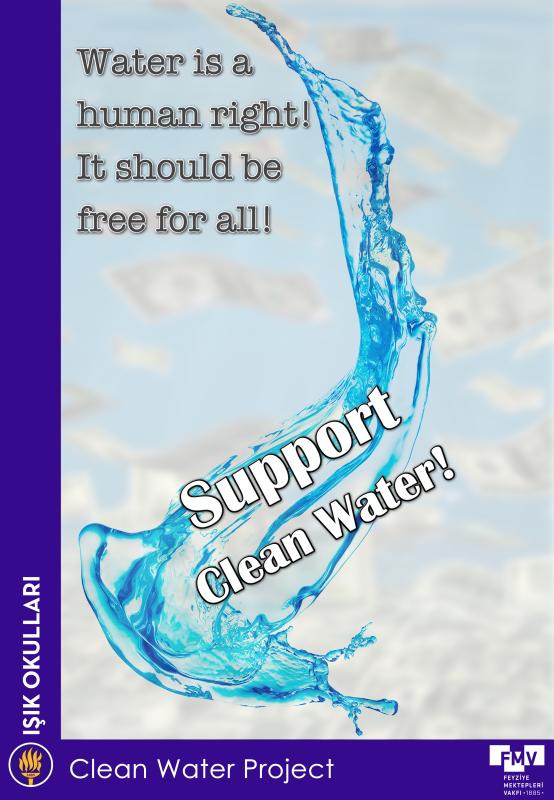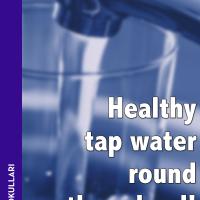
DRINKABLE TAP WATER
SUBJECT OF THE PROJECT:
In the past tap water was widely used for both drinking and daily use in Turkey. At that time, we did not pay for drinking water and were not suspicious about the water we drunk. What happened to make us look upon the water we drink as being different from the water we use for daily tasks? Was the water we used to drink from taps really unhealthy and is the water we drink from carboys any better?
For the past 15-20 years, tap water in our country has not been consumed. Water for daily use is supplied from taps and drinking water is supplied from taps and drinking water is supplied from carboy sinks. Which are purchased, are often a cause for concern. We under look some research on this subject and found a mass of pollution.
We believe that the quality of drinking water and tap water must be the same. This would benefit public health, because we use tap water to clean fruit and vegetables, to clean our hands and teeth etc. If tap water is seemed to be unhealthy for drinking then why do we use it for everyday things like cleaning vegetables etc.? We decided that something was going very wrong.
The idea of our project arises from two simple questions:
1) Why do we pay for our drinking water?
2) Can we drink the tap water in our school?
Therefore, our project focusses on the point that “Water is not a commodity. We deserve healthy water without paying for it. Clean water is a necessity.”
PROJECT OBJECTIVES:
This project aims to supply healthy water to students and staff at our school. The project provides energy and money savings ideas for transporting water to our school. This water project is a means of raising awareness about the water that we drink and it’s cleanliness.
PROJECT RESEARCH:
Firstly, we undertook research into the properties of healthy water.
Table 1. Classification of Water Hardness
Water hardness Germany France England
very soft 0 - 4 0 - 7,2 0 - 5
soft 5 - 8 7,3 - 14,2 6 - 10
Mean water 9 - 12 14,3 - 21,5 11 - 15
hard water 13 - 18 21,6 - 32,5 16 - 22.5
hard water 19 - 30 32,6 - 54,0 22,5 - 37,5
very hard water Bigger than30 Bigger than 54 Bigger than 37,5
(ABD water hardness = French water hardness x 10 1 French water hardness = 0,56 German water hardness = 0,70 English water hardness)
Table 2. List of National Secondary Drinking Water Regulations
Contaminant Secondary Standard
Aluminum 0.05 to 0.2 mg/L
Chloride 250 mg/L
Color 15 (color units)
Copper 1.0 mg/L
Corrosivity noncorrosive
Fluoride 2.0 mg/L
Foaming Agents 0.5 mg/L
Iron 0.3 mg/L
Manganese 0.05 mg/L
Odor 3 threshold odor number
pH 6.5-8.5
Silver 0.10 mg/L
Sulfate 250 mg/L
Total Dissolved Solids 500 mg/L
Zinc 5 mg/L
When we under look research into whether BPA in carboys was harmful to us we found much information to be unreliable. In this area of research there are many commercial and political interests. Therefore we chose to believe nothing.
BPA is a substance that hardens plastics. It was used in plastic baby bottles, which seemed a good substitute for glass because they didn't break. But after scientists realized it could leach into the contents of the bottle, consumers pressured manufacturers to remove it.
It is also widely used as a protective lining in food cans. Now that some studies have shown that BPA leaches into the food, consumer pressure is once again forcing companies to respond. The companies like FDA (Food and Drug Administration) maintain that BPA is safe, but that consumer trust is shaken.
BPA is an endocrine disruptor, and various studies have pointed to health effects, including disruption of the hormone system and cancer.
In the face of scientific studies that continue to raise disturbing questions about the long-term effects of BPA exposures, especially in fetuses, babies and young children.
The Meanings Of Numbers Under The Demijohns
No. 1 means --> PET or PETE (polyethylene terephthalate)
No. 2 means --> HDPE (high density poly ethylene)
No. 3 means --> PVC (poly vinyl chloride)
No. 4 means --> LDPE (low density polyethylene)
No. 5 means --> PP (polypropylene)
No. 6 means --> PS (polystyrene)
No. 7 means --> Polycarbonate (it could contain BPA)
When we make research about whether BPA in the demijohns is harmful for our body or not, we have found many unreliable information. At this area there are some political and commercial benefits. Therefore we couldn’t believe any of them.
If there are numbers 3, 6 and 7 under the plastics, it is inconvenient to save food or water in. In our school there is no number on the demijohns. The products must be consumed in 7 days after they are opened if they are bigger than 5 liters.
PROJECT ACTION PLAN:
First, we identified and contact our local public water system: We visited the city water treatment system called İSKİ (Istanbul Water and Sewage Plant) (attachment-1) where the water is treated and spread all over the Istanbul city. Our school supplies water from this system too.
Second, we made a series of power point presentation (attachments-2 and 3) to 5th, 6th and 7th grade students in our school to inform them about water treatment in İSKİ. This was a start to raise awareness about drinking safety and healthy water among the school public.
Third, the water from the İSKİ treatment plant, incoming water from İSKİ to the school, water coming from the school’s treatment unit and our tap water are analyzed by a certificated laboratory (ISDAŞ) (attachments-4, 5, 6, ). Our school water pipe system was partially changed in 2008. The pipeline system was changed in the location of our school in 2008 completely.
COMPARISON:
The water from İSKİ treatment unit: healthy
Water coming from İSKİ to the school: unhealthy
Water coming out from school’s treatment unit (our tap water): healthy
The tap water was very clean according to the analysis in school. However the taste was not good for drinking and it is not compatible with the Turkish people’s palate. So we decided to make the water taste better and make it rich in minerals.
Fourth, we started a campaign for this purpose in school. We prepared slogans and organized the 4th grade students. 4th grade students walked in the school announcing the slogans (attachment-7).
The slogans are;
The water is not a commodity!
We deserve healthy water without paying for it!
Tap water must be healthy!
We have prepared posters and hung them all over the school (attachments-8).
Fifth, we convinced the management of our school to change the school’s policy on water. They agreed with us that the tap water in school must be used as drinking water too. They decided to purify the tap water and bought a water treatment system that has many other facilities. The old water sinks are replaced with new water sinks that use our tap water (attachment-9).
Finally, we will make analysis of water biologically and chemically for both new system and old system.
PROJECT RESULTS:
The facilities of the new water system is given below:
What is Reverse Osmosis?
Reverse Osmosis is a technology that is used to remove a large majority of contaminants from water by pushing the water under pressure through a semi-permeable membrane.
The membrane is an essential material in the process of reverse osmosis. Without it, reverse osmosis cannot be done. The membrane is the main material that is responsible for completing the process of reverse osmosis, separating the impurities from pure water. The membrane filters and removes bacteria, viruses, salts, harmful chemicals, dissolved solids and all the other impurities and contaminants in the water. Membranes used in commercial reverse osmosis are usually made of cellulose acetate, polyamide and polysulfonate. The skins of these membranes serve as active barriers to impurities, while at the same time allowing pure water to pass through.
Reverse osmosis five-stage system provides an affordable alternative to bottled water.
• Manifold five stage,reverse osmosis, water filtration system
• Innovative one piece design
• Reduces: arsenic, cysts (cryptosporidium, giardia, entamoeba and/or toxoplasm), barium, hexavalent chromium, trivalent chromium, copper, lead, flüoride, cadmium, radium 226/228,selenium, TDS and turbidity
• İncludes a high capacity 3-gallon storage tank
• Built with a high production thin film membrane
• Provides bottled water quality
• Can be easily connected to an ice maker
We compared the biological and chemical analysis of water that we used to use and the water from the new system this is given in the attachments 10a, 10b.
The results are very revealing. We have now tasty and healthy drinking water.
PROJECT SUMMARY:
This water project promotes healthy and safe water for young people. They will drink water with enough calcium and magnesium that is necessary for their growth. The school saves money and they don’t have to pay for water. We have calculated that the school pays 1200 TL (26 892 $) for carboy water sink in a month. Our new water supply is 2000 TL (44 820 $) /one dispenser. If we buy three water sinks, they will cost totally 6000 TL (134 460 $). After 5 months the school will not pay for drinking water anymore. This was one of the aims of our project from the beginning. Our school foundation decided to use this system in the other two campuses.
